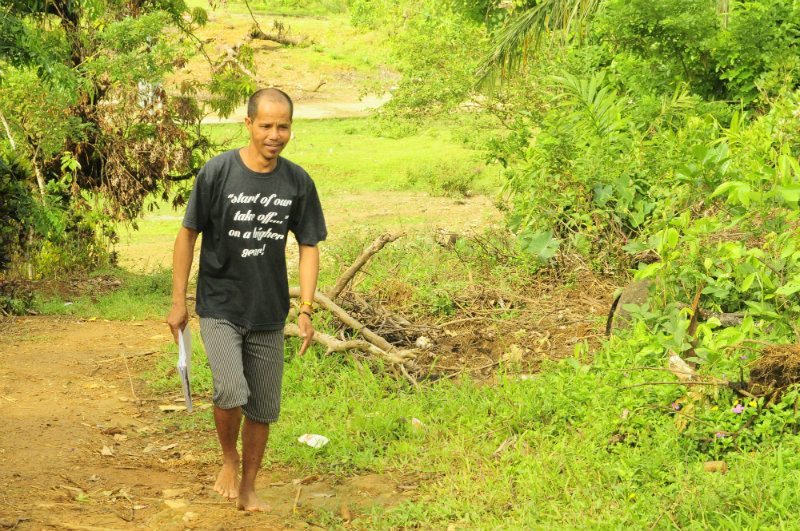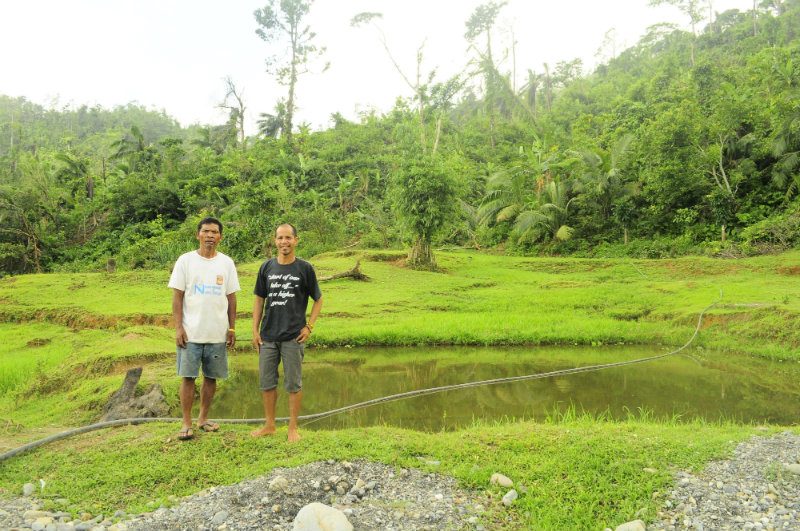SUMMARY
This is AI generated summarization, which may have errors. For context, always refer to the full article.

MANILA, Philippines – “Mangyan” is the umbrella term for the 8 indigenous groups of Mindoro. Originally coastal dwellers, they migrated to the mountains to escape from the Spanish colonizers and Moro raiders in the past.
The Alangan Mangyans dwell in northwest Central Mindoro, specifically the municipalities of Baco, Naujan, San Teodoro, and Victoria.
It is the end of another day. As the twilight sky turns a deep blue color and the cold breeze starts to drift from the mountains of Oriental Mindoro, darkness completely covers the land, save for the sole light from a fire burning in the middle of a big wooden house.
Around the fire, clusters of people of all ages are talking, laughing, or singing by the warmth of the flames, their shadows flickering on the wooden walls of the balaylakoy.
This is how Vicente Sara, an Alangan Mangyan from Barangay Caburo of Naujan, Oriental Mindoro, remembers his yester-years, back when their tribal culture flourished.
In the heart of Alangan culture
In the earlier days, the Alangan Mangyans were known to live in great houses, called balaylakoy, where up to 20 families shared one living space.
The traditional balaylakoy, typically having one room only, provided more than a home and protection for the Alangans. It was also a sacred place where indigenous rituals and gatherings were conducted.
Each year, during the harvest season, the Alangans celebrate the pamago. Each family residing in the balaylakoy contributes some of their harvest. Together, they pound rice to remove the husk in the palangganan, the center of the balaylakoy. Residents, visitors from other balaylakoys, and even outsiders, are welcome to feast on their harvest.
“Pinakamasayang panahon sa balaylakoy ang pamago,” Vicente Sara, more fondly called “Ka Beting”, cheerfully recounted. (The pamago is the happiest time in the balaylakoy)
This much awaited festivity is the Alangans’ thanksgiving for the bountiful harvest and their way of praying for the promise of the continuous richness of their lands. It is just one of their many ceremonies and rituals led by their greatly respected elder and healer, known as the aplaki.
Aside from rituals, the Alangans also gather around the fire that burns continuously every day in the palangganan, to resolve conflicts, plan for activities of their community, and more importantly, bond with their family.
Beting explained, while sharing stories and chewing betel nut around the fire in the palangganan, the aplaki also teaches the beliefs and values of the Alangans to the youth.
Through sharing stories and enjoying each other’s company through the telling of ambahan, which can be in the form of chants or songs, the Alangans preserved their culture and lived in harmony.
Because Alangans live together, almost all adults are able to work on their farm, as the children can be left with a guardian.
Wilma Garon, one of the older community members, said that various training on handicrafts and livelihood were also done in the balaylakoys.

“Lahat ng aspeto ng buhay ng katutubong Mangyan ay naka-angkla sa balaylakoy kaya ganoon na lang ang pagpapahalaga sa balaylakoy,” Ka Beting explained. (All aspects of the lives of the Mangyans are anchored on the balaylakoy, which is why we give it much importance.)
“Ang mga activity na ginagawa sa balaylakoy ay hindi pang-personal na interes and purpose kung hindi pang-komunidad,” he also said. (Activities conducted in the balaylakoy are not for personal interest and purpose, but for the community.)
Decline of tradition
However, due to the vast amount of external influences, many of the Alangan Mangyans today have shifted from the communal balaylakoy to individual houses. Actual balaylakoys have grown more uncommon in communities.
“Nakikita ko sa pamayanan naming Mangyan na naghahari na ang impluwensya na galing sa labas,” Ka Beting said. (I can see in our Mangyan community that external influences are becoming dominant.)
According to Domingo Torres, the Barangay Captain of Caburo, it has been almost 15 years since their last balaylakoy was destroyed by a typhoon.
The Alangans’ sense of unity and togetherness seems to be fading as the number of balaylakoys has lessened.
“Ilang pamayanan na lang ng katutubong Alangan ang may ganitong balaylakoy,” Ka Beting said. (Very few Alangan tribes still have a balaylakoy.)
Because the balaylakoy is strongly connected to their culture, their traditions and customs are slowly being forgotten, especially by the youth.
“Talamak na ang pagkakanya-kanya,” mourned Ka Beting. (Individualism is becoming widespread.)
With all the changes in their system, it has increasingly become a challenge for the aplaki and other community leaders to resolve problems within the village. Unlike before when difficulties are resolved as a unit, some choose to ignore issues that do not concern them, even if these are experienced by family members. As such, conflicts have become more difficult to resolve.
“Kapag nasa isang balaylakoy, hindi nila kayang sabihin na ‘bahala na yan’. Nandoon pa rin iyong pananagutan. Iyong problema nila, problema ko rin,” said Ka Beting. (In a balaylakoy, they can’t just say ‘come what may’. They are also liable for others’ problems. Their problems are my problems too.)
“Nalulungkot din kami na nakikita na ang aming kultura ay unti-unting naglalaho na kaya gustong-gusto naming ibalik ito,” Ka Beting said with determination. (We are saddened seeing our culture slowly disappear, which is why we want to bring it back.)
For many of the older members of the community, the balaylakoy remains a sacred place where tradition and rituals, spared by the effects of outside influence, are still practiced. Some yearn for the restoration of these communal houses, as they symbolize their culture.
“Kung hindi man tuluyang maibalik ang kultura namin dati ay unti-unting makita sana ng susunod na salinlahi kung gaano kahalaga at gaano kadaming gamit ang balaylakoy,” explained Ka Beting. (We may not be able to totally revive our culture, but we want the next generations to know the importance of the balaylakoy and its many uses.)
Preserving a culture of unity
The Alangan Mangyans know that the balaylakoy plays an important role in preserving their culture. As such, when the Kapit-Bisig Laban sa Kahirapan-Comprehensive and Integrated Delivery of Social Services (Kalahi-CIDSS) of the Department of Social Welfare and Development (DSWD) provided Barangay Caburo the opportunity to be part of it, they chose the construction of the balaylakoy as their sub-project.
According to Ka Beting, who was chosen the Barangay Sub-Project Management Committee chairperson, or the leader of the Kalahi-CIDSS community volunteers in the village, the core purpose of the balaylakoy is to ensure that the spirit of unity lives within the community. And to successfully build their balaylakoy, they will have to strengthen this characteristic and work in harmony.
Accordingly, the whole community has expressed their willingness help in the construction through bayanihan.
Modernized balaylakoy
Unlike the traditional balaylakoy that has an undivided interior with the palangganan at its center, the balaylakoy to be constructed through Kalahi-CIDSS will have concrete pillars, and will use indigenous materials such as wood and bamboo, for its walls and flooring. It will also have two extra rooms and a comfort room.
Its purpose, however, remains the same: to benefit the community. In fact, its functions are also projected to expand. Aside from serving as a communal home and venue for their rituals, it will also serve as a meeting place for large gatherings and assemblies.
The balaylakoy is also intended to accommodate students from other barangays studying in Barangay Caburo, especially during rainy days, when there are floods or when rivers become dangerous to cross because of the rising waters.
Once completed, part of the balaylakoy will also serve as the office of the Sangguniang Barangay. Ka Beting has high hopes for the balaylakoy, even if it has not been constructed yet.
“Buhay na buhay ang kultura sa balaylakoy,” he said. (The culture is very much alive in the balaylakoy.)
The community hopes that with construction of the balaylakoy, the rest of the tribe will be encouraged to protect and preserve their beliefs.
Their goal is that through the balaylakoy, the center of the Alangan Mangyans’ way of life, the youth and future generations will appreciate and be proud that they are part of a rich and beautiful culture. – Rappler.com
Melanie Sison is a communication specialist of Kalahi-CIDDS.
Add a comment
How does this make you feel?
There are no comments yet. Add your comment to start the conversation.